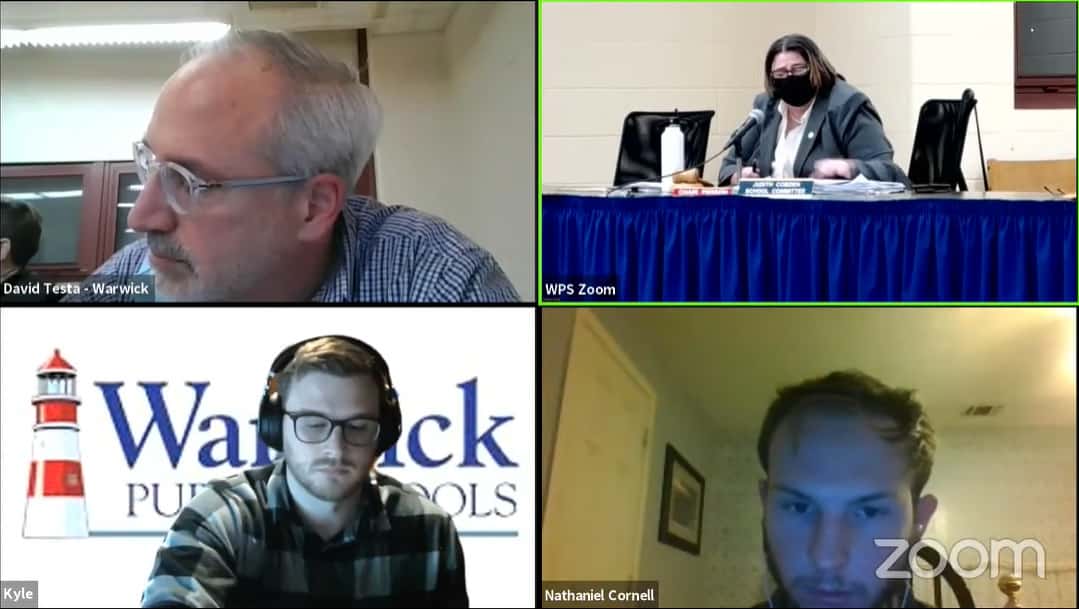

Warwick School Committee members discuss the new teachers contract on May 13, 2021.
Absent were public demonstrations, sick-outs, and court battles; instead, school officials and the union negotiated the new contract in the waning days of Supt. Phil Thornton’s tenure, months after the former Warwick teachers contract expired, and approved the 2020-23 agreement with relatively little fanfare.
It’s fair to say that this result is a welcome and long-overdue one in Warwick, coming amid the tumultuous COVID-impacted school year and other factors that gave the Warwick School Committee a unique chance to improve how the department is run.
Settling the new Warwick Teacher’s Contract was also an urgent need, as School Committee Chairwoman Judy Cobden explained when the board voted 3-2 in favor of the tentative agreement updating the former pact on the same night that it approved a $305 million high school improvement plan.
Noting the potential for a lawsuit if the school committee turned down the new proposal, Cobden said, “I don’t think this is a time to pick the battle,” adding that if the school board ultimately went to court, “[t]he tentative agreement is going to be thrown out the window and we’re going to be starting from scratch. It’s going to go on for years just like it did last time, and I object to doing that right now.”
But while the new contract arguably restores some of the leverage that the WTU gave up in the last one, it doesn’t erase how much the 2017 pact reduced the union’s control over items like layoffs and coaching vacancies. | Read: Which Side ‘Won’ the Warwick Teachers Contract Battle?
A review of the new agreement shows that the school committee gave up relatively little, and actually secured better terms in some important financial areas, to avoid more contract disputes.
Scorecard: Costs and concessions
In analyzing the new teachers contract, it’s important to review how it stacks up to the prior one, particularly in the areas that were most contentiously fought in the last round of negotiations.
Here’s a breakdown of what the old contract included, how the new one changes those terms, and which side benefits more from the differences between the two pacts.
Salaries: The 2017-20 contract included no pay increase in 2015-16, a 2-percent retroactive raise for half of the 2016-17 school year, a 3 percent raise beginning in October 2017 for the 2017-18 school year, and 3-percent raises in each 2018-19 and 2019-2020.
Under the new contract, teachers will get no retroactive pay increase for the 2020-21 school year and 2.5-percent hikes for the following two years. According to the fiscal impact statement released by the school department, salary increases will create a deficit of $2.4 million in the FY22 school budget and $4.8 million in the FY23 spending plan.
However, Director of Finance and Operations Robert Baxter explained in the statement that the FY22 amount “can be absorbed within the FY22 School Committee recommended budget with
negligible adjustments,” adding that the board could “eliminate the district’s structural deficit within terms of this [tentative agreement] assuming WTU staff reductions are made as a result of declining enrollment.”
In other words, Baxter is saying that the salary raises won’t increase future school budgets if the school committee cuts more teaching positions, like it did in approving 24 teacher layoffs recently.
Securing affordable pay hikes for teachers is essentially a win for both sides, as higher paychecks for teachers won’t come at the possible expense of educational or sports programs — or trigger a future tax increase.
Layoffs: Perhaps the hardest-fought element of the 2017-20 contract, the issue of layoffs went to the state labor relations board and eventually resulted in a court order allowing the school board to exceed the prior limit of 20 layoffs because of falling student enrollment.
When the school committee recently discussed layoffs heading into the FY22 budget cycle, WTU President Darlene Netcoh accused the board of using “spurious reasons” to justify cutting teacher positions.
“The administration alleges the district has lost 1,200 students yet has provided no timeframe for that supposedly precipitous decline,” Netcoh wrote in a letter read to the committee on May 19.
Enrollment information published by the Rhode Island Department of Education shows that Warwick had 9,393 students for 2013-14 and currently lists 8,140, a difference of 1,253 over the course of seven school years, or an average annual reduction of 179 students.
Under the new contract, enrollment figures for the 2017-18 school year — during which Warwick reported 8,953 students according to RIDE, or 813 more than its current population — will be used as the “base point” to determine whether a “substantial decline” in student enrollment has occurred, allowing the school committee to exceed the limits of 40 layoff notices and 20 layoffs included in the new agreement.
According to superintendent’s Executive Secretary Catherine Bonang, Warwick employed 914.8 teachers in 2017-18 [the decimal indicates part-time positions included in the total] and currently counts 887.8, a reduction of 27 full-time equivalent (FTE) positions, or 2.9 percent.
Keeping in mind that Warwick consolidated its high schools and closed elementary schools over the last four years, that reduction in teachers doesn’t correlate numerically with the 11-percent drop in student population.
While it’s not clear what represents a “substantial decline,” since the term isn’t defined in either the new contract or the former one, the school committee preserved the concession it secured in 2019 to lay off more teachers than the arbitrary limits set in prior contracts, signifying another clear win for the school board.
Benefits: Teachers will be paying 17 percent of the cost of their healthcare plans in 2021-22 and 18 percent in 2022-23, up from the current 14 percent. Baxter’s fiscal note states that the higher rates represent about $1 million in contributions by teachers over the next two years.
The copay changes will also affect how much the school district pays toward teacher healthcare plans, with an expected increase of $77,000 in FY22 and just under $780,000 in FY23. Without the higher teacher contributions, the district would be paying about $800,000 more in FY22 and about $1.8 million more in FY23.
By securing higher healthcare copays from union teachers, the school committee put another item in the ‘win’ column while improving the district’s financial picture.
Class sizes/ratios: After Thornton’s handling of the controversial practice triggered student protests in late 2016, the school committee eliminated so-called “weighting” in the last contract, referring to the practice of counting one student as 1.5 or 2 in terms of class size, depending on their need for special education services.
Instead, the last contract introduced a ratio system, where no more than 30 percent of the students in a classroom can be special education students. Both sides also agreed that kindergarten classes could have up to 22 students, with the limit for all other classrooms set at 26 students.
Those ratios and class limits don’t change with the 2020-23 contract, though there are several new details that govern how class sizes might be affected, including deadlines for ensuring that classes stay within the 30 percent ratio and the agreed-upon class sizes: For grades 6 through 12, the deadline will be the tenth day of the new school year; for grades 1 to 5, it will be the third day, and for kindergarten, the first day of school.
If any classes exceed the stated ratio or sizes after those dates, teachers would get additional pay for every day that their classroom stays above those limits.
Putting the ratio system in place over the WTU’s objections was a win for the school committee in 2017, and while the new pact sets deadlines and a requirement for the district to “demonstrate that reasonable efforts have been made to be in compliance” when classrooms exceed the size limits, those don’t end the ratio system.
As a result, the new contract’s language is a minor concession to the teachers union that doesn’t fundamentally change how class sizes are determined in Warwick.
Teacher evaluations: In the 2017-20 contract, school officials changed the process for evaluating teachers over the union’s objections to follow RIDE’s model, requiring three evaluation conferences to be held during the school year and performance improvement plans [PIPs] to be put in place when needed.
Teachers could cut the number of evaluations under the old contract to one every three years by scoring a rating of 4 or “highly effective,” and once every two years by earning a rating of 3 or “effective.”
Under the latest agreement, teachers will be completely exempt from evaluations for three full school years if they earn the top “highly effective” rating and two entire years for achieving the “effective” rating.
The two parties also agreed that the District Evaluation Committee (DEC) created by the prior contract will meet during the 2021-22 school year to create a Warwick Model Evaluation System that would take effect in the 2022-23 school year.
Comprised of 12 members, six each appointed by the superintendent and the union, the DEC is also charged with submitting the new evaluation plan to RIDE by Feb. 1, 2022.
Teachers will still be evaluated under the RIDE model, though they now have a longer time between observations if they score highly enough on those reviews, and their union representatives on the DEC can have a say in developing the next evaluation regime in Warwick.
This is another case where the school committee made a major overhaul to past practices in the last contract and a relatively small compromise in the new one.
Conclusion: With the new teachers contract, Warwick school officials needed to maintain labor peace and improve the department’s fiscal condition — and, although they gave ground in some areas, the other concessions that they secured from the WTU achieved those goals.
This is a test
